 Operation and Maintenance
Operation and Maintenance
 Windows Operation and Maintenance
Windows Operation and Maintenance
 Introduction to the simple method of configuring Win2008 load balancing under R2 (picture)
Introduction to the simple method of configuring Win2008 load balancing under R2 (picture)
Introduction to the simple method of configuring Win2008 load balancing under R2 (picture)
This article mainly introduces the load balancing method under Win2008 R2 (concise version with pictures and texts). Friends who need it can refer to
Two web servers, the operating system is Windows Server 2008 R2, apply for three IP addresses and the domain name to be load balanced (www.test.cn). One of the IP addresses is a virtual IP address, and the other two are configured on two servers respectively. For example:
Virtual IP: 11.1 .6.13 The addresses of the two servers are 11.1.6.11 and 11.1.6.12. The two services must install as follows:
Server (11.1.6.11): 1. Install load balancing service 2 . Configure load balancing operations on this server (the following takes this server as an example)
Server (11.1.6.12): 1. Install the load balancing service
Load balancing type: 1. When the same machine opens different pages, it connects to different servers (there is a Session sharing problem) 2. After one machine connects to the server, it will not go to another server (there is no Session sharing problem) The following is Take the two methods as examples
Install the service
Install the service on the server (11.1.6.11, 11.1.6.12) respectively. Take one of the servers as an example. Start=>Server Manager as shown below

Click on the add function on the right to enter and find "Remote Server Management Tools" -> "Network Load Balancing Tool" check the filter box Click Install. The following picture shows the picture after successful installation.

New clusters
After completing the above service installation, Start->Network Load Balancing Manager (taking the 11.1.6.11 server as an example)

Open the manager and select the "Network Load Balancing Cluster" item, right-click and select " New Cluster" The "New Cluster" page will pop up as shown below
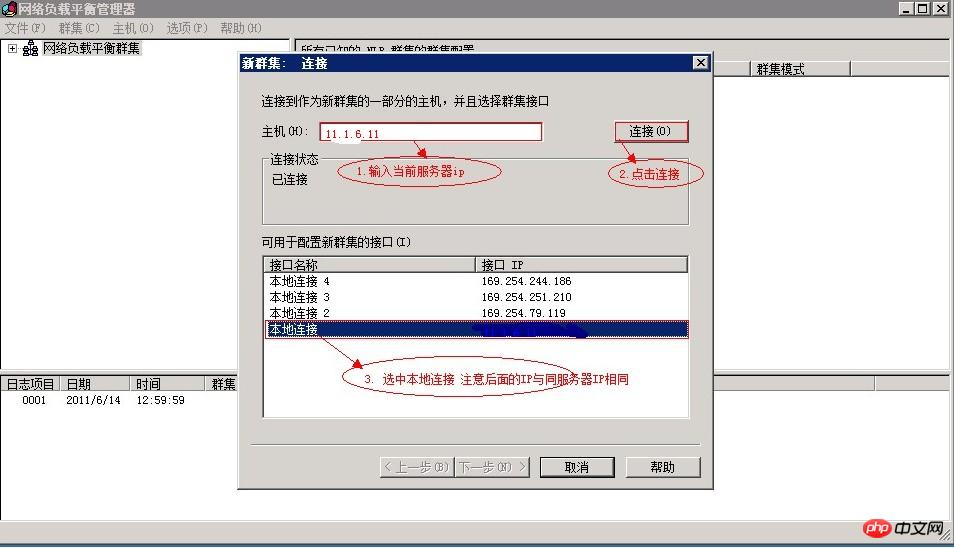
As shown above, double-click "Local Area Connection" in the above picture. When another interface pops up, press the default option and click "Next" Step" to enter the "New Cluster" page as shown below

Enter the IP address and subnet mask of the cluster and click "OK". Return to the cluster IP address page and click "Next ” and then enter the “Cluster Parameters” page as shown below
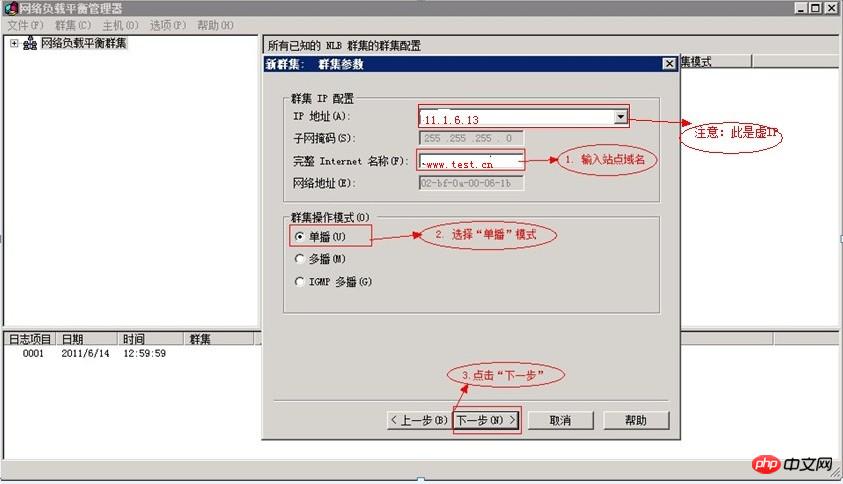
Enter the domain name (www.test.cn) in the “Full Internet Name” box, select “Unicast” mode and click "Next step" enters the "Port Rules" setting page as shown below

Select the existing port rule row and click "Edit" to pop up the port rule editing page and set the parameters as follows
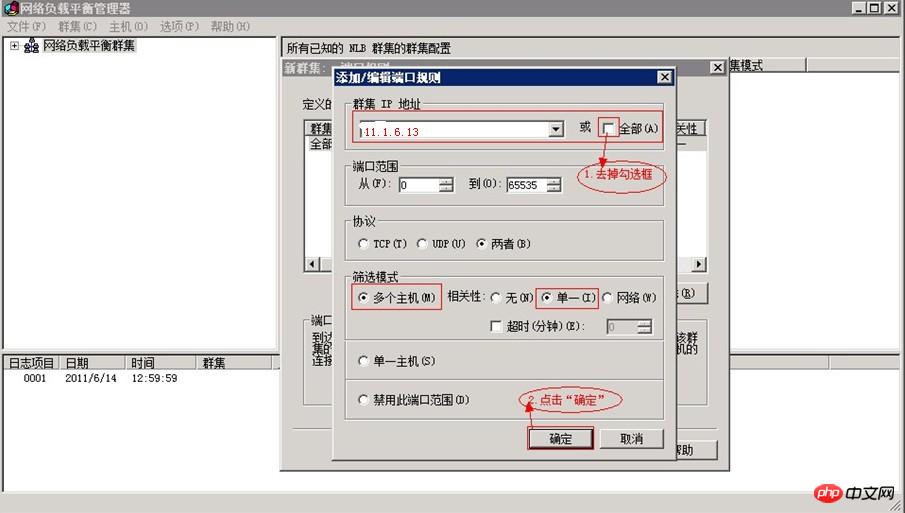
After that, keep clicking "Finish" and the installation will be completed, as shown in the picture:
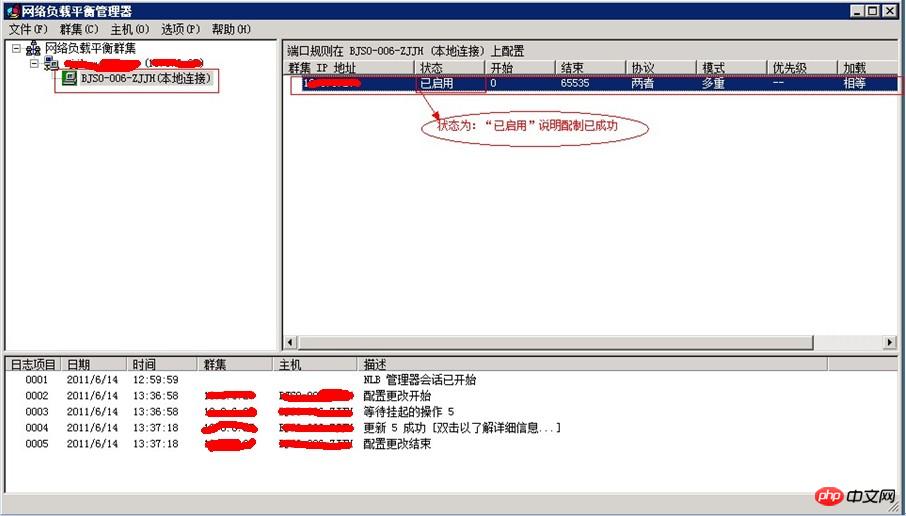
If you add another one, The cluster of the station is as shown below:

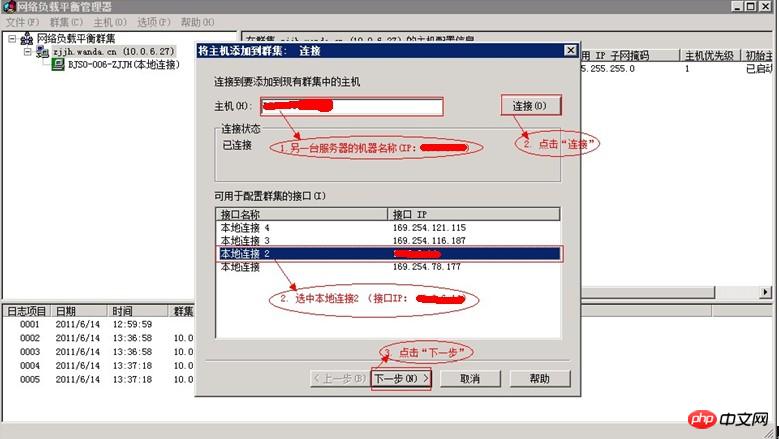
When adding the second station, enter the IP (11.1.6.12) in the host input box Sometimes it fails when clicking to connect, so
At this time, enter the "machine name" of another server (10.0.6.14) in the "Host" box and click "Connect" and then repeat the process of (11.1.6.11)
After the two machines are added, as shown in the figure
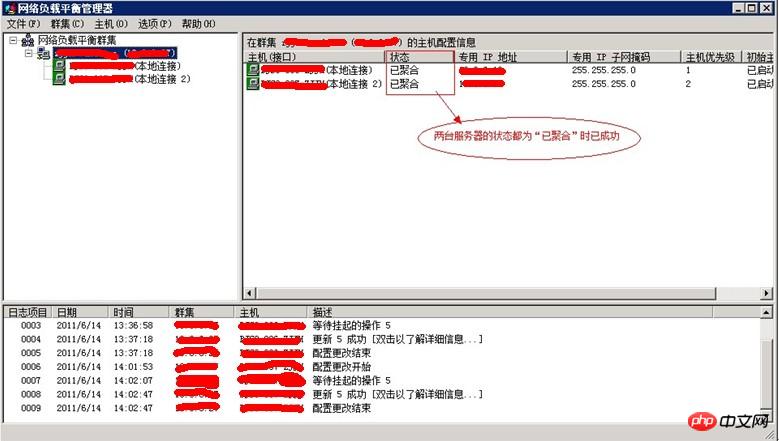
You can service and deploy the test network on two separate computers respectively. Open it on (www.test.cn) and you can see the different servers connected
The above is the detailed content of Introduction to the simple method of configuring Win2008 load balancing under R2 (picture). For more information, please follow other related articles on the PHP Chinese website!

Hot AI Tools

Undresser.AI Undress
AI-powered app for creating realistic nude photos

AI Clothes Remover
Online AI tool for removing clothes from photos.

Undress AI Tool
Undress images for free

Clothoff.io
AI clothes remover

Video Face Swap
Swap faces in any video effortlessly with our completely free AI face swap tool!

Hot Article

Hot Tools

Notepad++7.3.1
Easy-to-use and free code editor

SublimeText3 Chinese version
Chinese version, very easy to use

Zend Studio 13.0.1
Powerful PHP integrated development environment

Dreamweaver CS6
Visual web development tools

SublimeText3 Mac version
God-level code editing software (SublimeText3)

Hot Topics
 1386
1386
 52
52
 How to optimize TCP/IP performance and network performance of Linux systems
Nov 07, 2023 am 11:15 AM
How to optimize TCP/IP performance and network performance of Linux systems
Nov 07, 2023 am 11:15 AM
In the field of modern computers, the TCP/IP protocol is the basis for network communication. As an open source operating system, Linux has become the preferred operating system used by many businesses and organizations. However, as network applications and services become more and more critical components of business, administrators often need to optimize network performance to ensure fast and reliable data transfer. This article will introduce how to improve the network transmission speed of Linux systems by optimizing TCP/IP performance and network performance of Linux systems. This article will discuss a
 Failover and recovery mechanism in Nginx load balancing solution
Oct 15, 2023 am 11:14 AM
Failover and recovery mechanism in Nginx load balancing solution
Oct 15, 2023 am 11:14 AM
Introduction to the failover and recovery mechanism in the Nginx load balancing solution: For high-load websites, the use of load balancing is one of the important means to ensure high availability of the website and improve performance. As a powerful open source web server, Nginx's load balancing function has been widely used. In load balancing, how to implement failover and recovery mechanisms is an important issue that needs to be considered. This article will introduce the failover and recovery mechanism in Nginx load balancing and give specific code examples. 1. Failover mechanism
 Building a high-availability load balancing system: Best practices for Nginx Proxy Manager
Sep 27, 2023 am 08:22 AM
Building a high-availability load balancing system: Best practices for Nginx Proxy Manager
Sep 27, 2023 am 08:22 AM
Building a high-availability load balancing system: Best practices for NginxProxyManager Introduction: In the development of Internet applications, the load balancing system is one of the essential components. It can achieve high concurrency and high availability services by distributing requests to multiple servers. NginxProxyManager is a commonly used load balancing software. This article will introduce how to use NginxProxyManager to build a high-availability load balancing system and provide
 High availability and disaster recovery solution for Nginx load balancing solution
Oct 15, 2023 am 11:43 AM
High availability and disaster recovery solution for Nginx load balancing solution
Oct 15, 2023 am 11:43 AM
High Availability and Disaster Recovery Solution of Nginx Load Balancing Solution With the rapid development of the Internet, the high availability of Web services has become a key requirement. In order to achieve high availability and disaster tolerance, Nginx has always been one of the most commonly used and reliable load balancers. In this article, we will introduce Nginx’s high availability and disaster recovery solutions and provide specific code examples. High availability of Nginx is mainly achieved through the use of multiple servers. As a load balancer, Nginx can distribute traffic to multiple backend servers to
 Dynamic failure detection and load weight adjustment strategy in Nginx load balancing solution
Oct 15, 2023 pm 03:54 PM
Dynamic failure detection and load weight adjustment strategy in Nginx load balancing solution
Oct 15, 2023 pm 03:54 PM
Dynamic failure detection and load weight adjustment strategies in the Nginx load balancing solution require specific code examples. Introduction In high-concurrency network environments, load balancing is a common solution that can effectively improve the availability and performance of the website. Nginx is an open source, high-performance web server that provides powerful load balancing capabilities. This article will introduce two important features in Nginx load balancing, dynamic failure detection and load weight adjustment strategy, and provide specific code examples. 1. Dynamic failure detection Dynamic failure detection
 Application of load balancing strategy in Java framework performance optimization
May 31, 2024 pm 08:02 PM
Application of load balancing strategy in Java framework performance optimization
May 31, 2024 pm 08:02 PM
Load balancing strategies are crucial in Java frameworks for efficient distribution of requests. Depending on the concurrency situation, different strategies have different performance: Polling method: stable performance under low concurrency. Weighted polling method: The performance is similar to the polling method under low concurrency. Least number of connections method: best performance under high concurrency. Random method: simple but poor performance. Consistent Hashing: Balancing server load. Combined with practical cases, this article explains how to choose appropriate strategies based on performance data to significantly improve application performance.
 Using Nginx Proxy Manager to implement reverse proxy load balancing strategy
Sep 26, 2023 pm 12:05 PM
Using Nginx Proxy Manager to implement reverse proxy load balancing strategy
Sep 26, 2023 pm 12:05 PM
Use NginxProxyManager to implement reverse proxy load balancing strategy NginxProxyManager is an Nginx-based proxy management tool that can help us easily implement reverse proxy and load balancing. By configuring NginxProxyManager, we can distribute requests to multiple backend servers to achieve load balancing and improve system availability and performance. 1. Install and configure NginxProxyManager
 Backend server health check and dynamic adjustment in Nginx load balancing solution
Oct 15, 2023 am 11:37 AM
Backend server health check and dynamic adjustment in Nginx load balancing solution
Oct 15, 2023 am 11:37 AM
Backend server health check and dynamic adjustment in the Nginx load balancing solution require specific code examples Summary: In the Nginx load balancing solution, the health status of the backend server is an important consideration. This article will introduce how to use Nginx's health check module and dynamic adjustment module to implement health check and dynamic adjustment of the back-end server, and give specific code examples. Introduction In modern application architecture, load balancing is one of the commonly used solutions to improve application performance and reliability. Ngi



